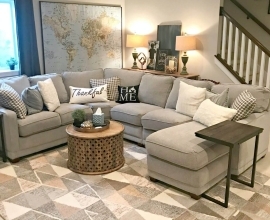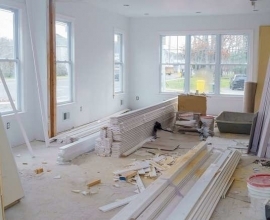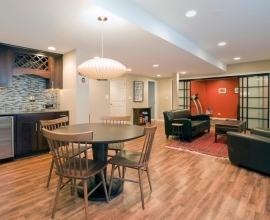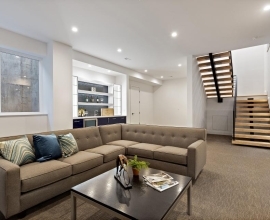The Kitchen Renovation Doesn’t Have to Be As Painful As You Might Think
You’ve reached your own personal tipping point: the toaster won’t work when the coffeemaker’s on, you’re down to one working burner on your stove, only one person can be in the kitchen at a time so your family eats in shifts, and finally the microwave blew on the morning of your big presentation at work, and you decided, “Enough is enough. We need a new, functional kitchen!”
You’re not alone. Usually everyone has a particular tipping point; that one last thing that sends them into the renovation pool. You try to hold on for as long as you can because you’re dreading the noise, the dust, the inconvenience and the disruption to your daily life. When your space becomes unusable, it’s time to do something. But you can’t just jump into a renovation, particularly one as costly, time consuming and inconvenient as a kitchen renovation, you need a well thought out plan of attack if you’re going to pull it off in the quickest amount of time with the least amount of inconvenience and expense.
Start by developing a Design Plan: A renovation will only be as successful as the research and planning that’s put into it. Like any business proposal you develop for work, you need to have a clear goal of what you want to achieve with the renovation. Do you yearn for updated electrical wiring, maximizing storage space, adding an eating area, appliances that work?
You can start by popping into kitchen renovation stores to look at the latest available features in kitchen design. Speak to the staff, tell them you’re at the beginning of your journey and see if they have any ideas for you.
Cut out photos of kitchens you love from magazines and put them in a folder. Identify why you like the kitchens you’ve chosen – is it the space? The lighting? The colour? The style of cabinetry or countertops? It is even helpful to give your designer images of things you definitely do not like. That way they won’t propose those very things in your dream kitchen. When you determine what you really want, it will help your kitchen designer draw up the plans that suit you.
If you have a friend who’s recently renovated her kitchen, take pictures and identify what you like about it as well and stick it in the folder with your other pictures.
Toronto architect Jacqueline Rhee says that when she sits down with potential clients and they say to her, “Design us something gorgeous,” she has to explain that they aren’t giving her enough information. She says, “What their idea of ‘gorgeous’ is and what I might have in mind could very well be two different things. Maybe they want French Country, but I have an idea that they might prefer a sleek contemporary kitchen.” The more direction clients can give their designer about their likes, dislikes and what their goals for the space are, the better the design can live up to their expectations.
Budget: The good news regarding a kitchen renovation is that it tends to be a good investment. The Appraisal Institute of Canada estimates that a kitchen renovation will return 75-100% of your investment if you were to turn around and sell your home. However, the sky is never the limit, even for Donald Trump. Just as you would plan your company’s annual marketing budget, you need to develop a budget for your kitchen renovation. A general rule of thumb for how much to spend on a kitchen renovation is up to 10-15% of the value of your home. But don’t feel like you have to spend that much; if you can do more with less, do it. For example, if your cabinets are in the right location and sturdy but just tired and outdated, consider refacing them. Refacing comes in at about 50-75% of the cost of new custom cabinetry.
Hiring a Kitchen Company and/or Contractor: Most people hire a contractor or kitchen designer through word of mouth. If you’ve been to a friend’s recently renovated house and you like what you see, start asking questions: Who did the work? Did you work well together? Was he on time and on budget? Is the end result what you expected? Was he well-organized or did you scramble to get finishes at the last minute? Were there any major problems during construction, and if so, how did he handle them? If you liked the answers your friend gave you – assuming your friend isn’t shell-shocked from the direct grilling she’s just received – get his card. Now, find at least two other contractors and/or kitchen companies so you can compare quotes.
Meeting with the Designer and Contractor: If, while you’re meeting with a designer or contractor, your gut tells you that no matter how great the work is you couldn’t stand being in the same room with him for more than a minute, cross him off your list of candidates. You may have to meet with this person every day. If your personalities don’t mix, you’ll never be able to solve problems together. Likely, however, if you’re getting that vibe, the contractor or designer is too; it’s best to part ways before a relationship has begun.
If, on the other hand, your first meeting is fantastic and you’re bowled over with his enthusiasm and ideas and you get along as if you’d known each other your entire lives, you still need to do your research. Ask him how many jobs he can handle at once and how many he has going currently and make sure he is bonded and insured.
Further necessary research – the internet is your new best friend: Researching kitchen companies and contractors has become a whole lot easier with the age of the internet. Now there are websites which are specifically focused on capturing word-of-mouth reviews from consumers online. If the companies you’re interested in using don’t have any reviews, you may want to look at other companies that do and compare their services. Also check out the company’s website. If they don’t have one, you have to wonder how professional they are.
Another tip you can try is entering the company’s name in search engines like Google and Yahoo!. You may find some feedback people have posted on them on various forums. You can also post a question asking if anyone has ever used this company. Finally, check the references he or she gives you as well, talk to a few of his past clients and go see the work he or she did for them.
Once you’ve chosen your designer, contractor and/or kitchen company, get ready: Ask yourself if you can live through the renovation by setting up a second kitchen in the garage or basement. Do you have toddlers who would be better off away from the construction site? Make arrangements to be out of the house for a specific amount of time and make sure that you and your project team have discussed the most reasonable move-out and move-in dates.
Did you have to factor furniture storage into your budget or can it be wrapped and stored on site? Again, your contractor will tell you which is the best option depending on the size of the job and your storage space availability on site.
During the renovation: Assumptions: One of the breakdowns in communication between homeowner and contractor is in assumptions made by one party or the other. For instance, one woman had purchased bathroom sinks and fixtures for a brand new home. The contractor saw that the powder room fixture would be outfitted with separate taps and a faucet and so drilled three holes in all the sinks because he assumed that all the fixtures were the same. Unfortunately, they weren’t and the homeowner had to replace the other fixtures to match the holes.
But incorrect assumptions can just as easily be made by the homeowner. A homeowner handed a water filter kit to the contractor and asked him to install it. The homeowner had read on the box that the water filter was good for the whole house and could be fitted on the main water supply. When she returned at the end of the day, the contractor had installed it under the kitchen sink. She’d never told him where it was to go, she had just assumed that he knew it was meant for the entire house.
Problem solving: In any renovation, no matter how minor, there always seem to be unforeseen problems. It’s not as surprising as you might think. What happens behind the walls stays behind them until they’re ripped apart. Up until then, you might not know that the insulation used was actually newspaper, or that the plumbing went through the wall that needs to be demolished. How your contractor and you handle these problems depends on how proactive your contractor is.
During Sue and Leon’s main floor renovation, the designer had called for the laundry room backsplash to consist of stainless steel tiles; beautiful, but at a cost of approximately $5,000. Sue balked. The contractor suggested instead a row of the tiles, two feet high, just behind the washer and dryer at a cost of $500. Sue was grateful that contractor made her aware of the costs and had an alternative suggestion for her.
The end result — your dream space: Living through the dust, noise and strangers in your house for weeks to months on end can be tiring. Even though you get along well with the crew and your contractor, you can find your temper becoming short, particularly if there are delays during the project leading to prolonged construction. Recognize that delays are often unavoidable and that one day, you will be back in your home, the workers will be gone and your new beautiful kitchen will be all yours.
On-line Resources: This Old House: This website is a DIYer’s dream. There are videos and tips on probably every aspect of renovating a kitchen. Kitchens.com: A wealth of information on everything you ever wanted to know about kitchens, including information on “greening your kitchen.” Better Homes and Gardens has an extensive section on renovating your kitchen including an “inspiration gallery” to give you some ideas. The Canada Mortgage and Housing Corporation: CMHC has an excellent website for any renovation or home purchase. The kitchen renovation area has downloadable charts you can use for reference guides as you go about your renovation planning. Appraisal Institute of Canada: The Renova section of this website allows you to input the cost of your renovation and it will calculate how much of a return you would receive if you sold your home.
On-line Forums: Forums are a great place to ask questions about all kinds of different topics. Search forums first to see if a thread already exists on the topic you’re interested in.
HomeStars Forum.
This Old House Forum.
Bob Vila’s Forum.
Style at Home Forum.
Canadian House and Home Forum.
Holmes on Homes Forum.
Article Source: https://bit.ly/36Z0qDw







